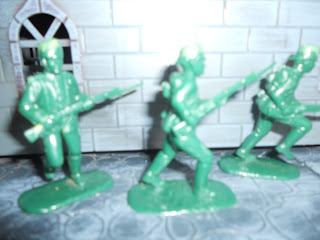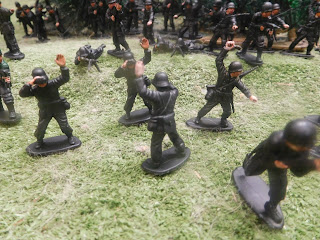January 2024 ElastoWit On The Workbench - The Thing, Planet Of The Apes, The Sacrecrow, The Lost World
The Thing humans are great character figures for any modern scenario. I gave the set pale neutral base colors so they can be put in any situation. Most of 'The Thing' occurred indoors but the pale color can pass as snow.
The POTA figures are just so cool! This is my second series set and I am awaiting the third. The bright green bases contrast nicely with the purple.
The pilot is a very snazzy looking bloke, in leather jacket and peaked cap. He could be used in all kinds of modern conflicts, including Vietnam.
Here is a break from ElastoWit. The lefthand figure is a WW2 American officer, MPC or Lido, I think. When I was a small boy one of the exciting things was getting cereal packet toys and cards. One series was 'Warriors of the World'. I got them in silver plastic, and they were among the first figures I ever painted. I often thought of what countries and eras were NOT covered and eventually, as a teen and then an adult, I converted a few of them. This recent conversion was the US cavalry figure given a new metal head to become a colonial British officer. The sword was unimpressive, so I replaced it with a spare DSG one.
Horses for gorillas: Billy, in the US, kindly sent me a box of figures, including these Lido medieval horses. I haven't decided if they will be the final mounts for my gorillas. The rider at left is ElastoWit and the one at right a metal casting from the MPC figure. His right eye did not come out properly, so I made it into an eye patch. he is a bigger figure than the Ukrainian figure. The horse armor is not something from the 1960s and 70s films but something like it was used in the 21st century reboot.
These two missed out on being painted but I'll do them later.
I have a few details left to paint before the figures are overcoated.
I have discovered a few things about undercoating and ovecoating ElastWit figures. You can apply the same lesson to painting any rubbery plastic. I undercoated the figures in ModgePodge and allowed them to set for three days before giving them a spray of white, bone or black games Workshop undercoat. I then painted them with acrylics, mostly model Color or GW. As I was painting the figures I noticed that the bases of the figure not undercoated with Modge Podge transferred any white undercoat to my fingers. This also applied to any parts of the boots that I missed with Modge Podge.
The next step is to overcoat the figures with Modge Podge and wait three days before coating with an additional clear coat - I use artist fixative 'Crystal Coat' but Model Color brushed on clear varnishes I also use, sometimes as yet another coat over the Crystal Coat. I can experiment then with satin, gloss and mat. I rarely end up with a completely flat finish, but a lot of things are not so anyway. Horses and leather for example have a sheen. Even healthy human skin has a slight sheen, and more so if sweaty in hot weather! In any case I often prefer a sheen on the whole figure. Others might prefer gloss but I use that primarily for armor finishes.
PVA (white glue) could also be used instead of Modge Podge. The latter is a mix of PVA and varnish and I am counting on it being a bit tougher than straight PVA. A couple of small drops of detergent mixed in helps with the floe. It is important to not let it pool too much anywhere on figures, especially with overcoats or it will become less than transparent. Modge Podge comes in mat and gloss finishes. PVA varies in finish.
This same procedure can be used for non-rubbery soft plastics although I usually use clear plastic car undercoat prior to the GW spray paint. Don't do that on the rubbery plastics. And don't use enamels. In fact, I still use enamels but usually just for metal figures.

















Wow! What a flying start on the new year!!
ReplyDeleteYou're very active painting. When you paint 'an army', how many members are you painting for your army or how big are those units? I made 2 platoons once (about 65 troopers)tro, and it felt like it took like forever.
I can second the use of Mod Podge(!) It's very useful. I'm going to make tarpaulin out of fragile tissue-paper which will survival outdoor use, and here I find several coats of Mod Podge very usefull so far.
I'm looking forward to follow your blog in 2024. Happy new year.
My armies don't tend to have a specific number in mind but just get added to as I feel like creating a new unit or character. My biggest armies are my ACW and medieval. If I included my unpainted factory painted Britains Detail along with figures I have painted maybe 600 + figures a side. I'm not sure. I don't keep tabs. My friend Bob has armies in the thousands. I find most of my battles involved two or three hundred figures a side, depending on outcomes of secret map moves. Some battles are much smaller. Normally there are just two players and moving too many figures can become tedious but are good when if are teams.
DeleteI also multipurpose some units. My ACW slouch hat Confederates double as Texans in the war with Mexico, volunteers in the Mexican War etc. My Union troops have doubled as Gerlosteiners and even Japanese. My AIP Japanese double as Federales in the Mexican Revolution and my Boers as less uniform Mexicans. My napoleoinics double as mexicans and as Land Of Ozzz Quadling troops.
I got the idea of using Modge Podge from you, although, previously I used and still sometimes use, straight PVA wood glue.
ReplyDeleteAs for what figures I paint, I often just paint individual figures that have little relationship to each other but I just like the look of them. However, individual figures can be added to existing units and projects. I also paint sets, like with the ElastoWit ones.
My groups of civilians, cowboys and Indians, fantasy, medieval and SF 'units' tend to be built up gradually, just adding individual figures that I find and like the look of.
When I specifically paint units I do half units of 12 or full units of 14 (if infantry) and usually 6 and 12 for cavalry. Thay is when I paint all faces, eyes, rifles, etc on the half unit or full unit and then go on to the next item.
Sorry, full units are usually 24 infantry.
ReplyDeleteThat's about a platoon size. So far I have only 2 armies made to a platoon size, which I've been using over and over for those 'bigger' battles. When making new 'armies' for new scenarios, I tend to go for something smaller a like a 'skirmish' and only make a sqad/section or so, divided into 2 or 3 fireteams. This gives me few and smaller units which take shorter time to paint.
DeleteI generally say they are 'regiments' although real regiments are hundreds of men. That way I have an excuse for greater variety of uniforms and flags. To contradict that I also have hero figures and count each figure as if he was an individual. My average battle has about 12 - 15 units per side, usually mostly infantry.
Delete